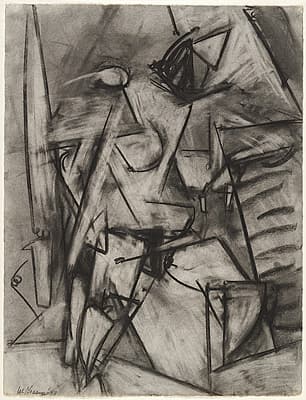
Lee
KRASNER
United States of America
1908
–
1984
Nude study from life
1938
charcoal
on paper
signed and dated l.l. in pencil "Lee Krasner '38".
image
63.0 (h)
x 48.4 (w)
cm
Purchased 1980
National Gallery of Australia, Canberra
NGA 1980.3421
© Lee Krasner/ARS. Licensed by Viscopy
- the artist;
- from whom bought, through Pace Gallery, by the Australian National Gallery, Canberra, October 1980
- Michelangelo to Matisse: Drawing the Figure
- Art Gallery of New South Wales 20 Nov 1999 – 27 Feb 2000
- Abstract Expressionism: the National Gallery of Australia celebrates the centenaries of Jackson Pollock and Morris Louis
- 14 Jul 2012 – 24 Feb 2013
- Ellen G. Landau, Lee Krasner: A catalogue raisonné, New York: Harry N. Abrams 1995, cat. 65, pp. 45–46, p. 48, illus. b&w
- Terence Maloon and Peter Peter, Michelangelo to Matisse: Drawing the figure, Sydney: Art Gallery of New South Wales, 1999, cat. 221, p.203, illus. b&w
In proposing the acquisition of these two early charcoal drawings in 1980, James Mollison AO, then Director of the National Gallery of Australia, wrote to Lee Krasner expressing his conviction that her drawings ‘… take us back to that critical moment in the history of the New York School—the late 1930s and early 1940s—when its radical aesthetic was first being formulated’.[1] Indeed, Krasner’s early drawings, alongside those of Hans Hofmann and Jackson Pollock, represent the first seeds of what was to become the major American art movement of the twentieth century.
In the early 1930s Krasner regularly visited the Museum of Modern Art in New York to analyse, absorb and emulate the works of the European Modernists: de Chirico, Miró and Henri Matisse were among her favourites. During this period Krasner was also taking life drawing classes, under various instructors and producing studies of the nude in pencil, conté crayon, ink and charcoal. In 1937 Krasner enrolled at the Hans Hofmann School of Fine Arts and, for the first time, became seriously engaged with Cubism.
These charcoal drawings, both titled ‘Nude study from life’, were completed a year apart, in 1938 and 1939, during the morning session life drawing classes directed by Hofmann. By this stage in her study, Krasner had absorbed her lessons in Cubist space and was beginning to resent having to refer to at what was in front of her. The charcoal drawings reveal a deeper, kinaesthetic approach to her drawing project: Krasner is deliberately deforming the figure, recording the perceived tension, weight and motion of the body through several moments in time through her own, now exaggerated, mark-making. Combining sharp, resolute black lines with textured areas of scrubbed white erasures, the surface of the drawings are infused with the vigour of the artist’s rapid gestures. It is precisely such palpable action that exposes Krasner’s determined move beyond Cubism and into a new, unexplored territory of her own individual and expressive style.
In 1976 Krasner re-discovered this group of 1930s charcoal figure studies. Setting aside those that she wished to keep, she harvested the rest, cutting them up and using the pieces as collage material for the 1977 series of paintings Eleven ways to use the words. In discussing this process with writer John Bernard Myers, Krasner stated in 1984, ‘They surprised me [the drawings] … I experienced the need not just to examine these drawings, but a peremptory desire to change them: a command as it were, to make them anew’.[2]. Critically and creatively revisiting and reusing these early works allowed the mature Krasner to assess her development as an artist and to propel her, once again, in a new direction.
Jaklyn Babington
[1] James Mollison in correspondence with Lee Krasner, 25 September 1980, NGA file 78: 0059, folio 77a.
[2] Ellen G. Landau, Lee Krasner: A catalogue raisonné, Harry N. Abrams, New York, 1995, p. 278.
The National Gallery of Australia holds a painting and five other works of paper by Krasner: a still life from the late 1930s, an oil and gouache collage from 1953, and three lithographs.
